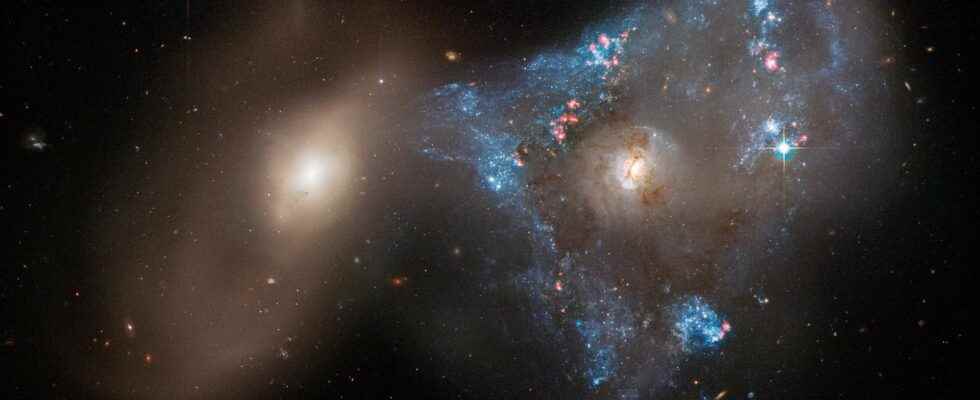The Nasa and theESA recently uploaded stunning images taken by the telescope Hubble showing some examples of colliding galaxies that are part of L’Atlas of Peculiar Galaxies, also commonly called atlas Arp. It is an astronomical catalog showing particular galaxies that we owe initially to the deceased astronomer American Halton Arp (1927-2013). He first published it in 1966, and when he died he listed 338 galaxies.
Halton Arp, just like Fred Hoyle, Margaret and Geoffrey Burbidgewill remain an opponent of the theory of big Bang of the late 1960s (despite the discovery of the cosmic radiation) till today. He questioned, like Hoyle, the interpretation of the spectral shift according to the Hubble-Lemaître law in terms of the expansion of space. This discrepancy had to have another interpretation, for example within the framework of a theory of light tired, involving a continual loss ofenergy from photons issued by the stars with the distance without this loss corresponding to a shift towards large wavelengthsso from blue to red, is due to the dilation continuous and accumulated wavelengths of photons due to the expansion of space during their journey.
The pair of interacting galaxies collectively called Arp 143. The pair contains the distorted star-forming spiral galaxy NGC 2445, right, and its minus companion, NGC 2444, left. © NASA, ESA, STScI, and J. Dalcanton (Center for Computational Astrophysics/Flatiron Inst., UWashington)
Galaxies that do not invalidate the Big Bang theory
The theory of tired light was nevertheless untenable, as the great Russian cosmologist Yakov Zeldovich quickly showed for the first time. According to the known laws of physics, any loss of energy according to fatigued light theory would involve a random loss of amount of movement for photons by interaction with their environment, for example intergalactic dust, so that the images of stars and galaxies would be more and more degraded with distance, which is absolutely not observed.
Moreover, as explained by cosmologist Ned Wrightthe relativistic expansion of space implies that the evolution time of the light curve of the explosions of supernovae must appear dilated according to a very precise law, a dilation that no theory of tired light can predict. However, not only has the phenomenon and the predicted law been observed, but the disagreement between the theory of tired light and the observations is 11 sigma, as the researchers say in their jargon. It is a colossal disagreement.
Arp was troubled by the fact that some of the objects in his catalog showed galaxies interacting or at least appeared so probably because of their closeness on the celestial vault. However, these galaxies had different spectral shifts, contradicting their apparently close associations involving distances similar to the Milky Way. Quite logically, Harp deduced that this refuted the standard theory of spectral shifting. A well-known example is Stephan’s Quintet, a visual grouping of 5 galaxies located in the pegasus constellation and observed for the first time by the French astronomer Édouard Stephan in 1878. In fact, only 4 galaxies are truly in interaction and as in all the other cases which troubled Harp, it was possible to show that the differences in shift were indeed due to different spatial distances and the associations on the celestial vault were simple asterisms like the constellations.
Comments on Arp 143. To obtain a fairly accurate French translation, click on the white rectangle at the bottom right. The English subtitles should then appear. Then click on the nut to the right of the rectangle, then on “Subtitles” and finally on “Translate automatically”. Choose “French”. © NASA’s Goddard Space Flight Center, Lead Producer : Paul Morris
Hubble and Arp’s catalog
The latest image uploaded by NASA and ESA shows NGC 2444, one lenticular galaxy ring located in the constellation of Lynx at about 180-200 millionlight years of the Milky Way discovered by the French astronomer Édouard Stephan in 1877, as well as NGC 2445, also a ring galaxy but irregular and which is undoubtedly in interaction with NGC 2444.
NGC 2445 was also discovered in 1877 by Édouard Stephan and the two galaxies are collectively called today Arp 143. Recall that a ring galaxy is a ring-shaped galaxy where it is made up of massive blue stars and relatively young who are extremely bright. The astrophysicists believe that ring galaxies form when a galaxy passes through the center of a larger galaxy. the gas self-gravitating stars of galaxies can be considered essentially collisionless but the gravitational disturbances caused by such an event can cause shock waves in the interstellar medium containing clouds molecules, causing their collapse gravity and thus a propagating star formation wave.
This is believed to have happened with Arp 143 between 50 and 100 million years ago, hence the burst of new star formation visible in NGC 2445. The triangular shape of this galaxy is thought to be due to gravitational forces distorting its ring structure. NGC 2444 contains old stars and no new star births because it lost its gas long ago, long before this galactic encounter.
Just over a week before Arp 143, NASA uploaded another Hubble image showing Arp 282, an interacting galaxy pair consisting of the Seyfert galaxy NGC 169 (bottom) and the galaxy IC 1559 ( at the top). NGC 169 is a spiral galaxy located in the andromeda constellation about 205 million light-years from the Milky Way. It was discovered by Irish astronomer RJ Mitchell in 1857.
These two galaxies are in interaction via from tidal forces which distort them and eject gas and stars. They both house active galactic nuclei which it seems well established for some time that they derive their energy from the accretion of matter by central supermassive black holes.
Several objects from the Halton Arp catalog are featured in this video. © Nas, Esa, go astronomy
Interested in what you just read?
